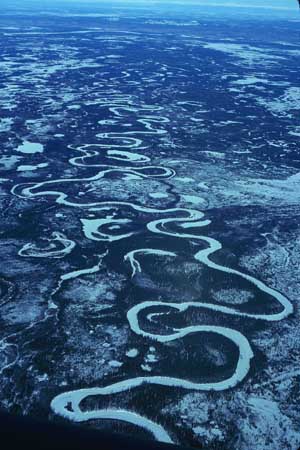|
|
 2 tundra, river meander DHJanzen101135.jpg high resolution
|
|
|
Moving away from the mountains to the flatland tundra - ancient sea beds, some planed flat by glaciers, much not but rather just deposited that way - northeast of Anchorage another arctic comes into view. In March the rivers are still frozen into icey highways. The black forest from horizon to horizon is a single evergreen species - black spruce - see below. Imagine what THAT means for animal-plant interactions, for secondary compound chemistry, for hunter-gatherers. And the rivers meander and meander - a sure signal of a very flat place, a place where a river cannot gain enough momentum to breach its banks and carve a straight channel, even with the run-off from melting spring snow. The ox-bow lakes are very evident here. And if you could see it, the permafrost underlying all of this would also cover from horizon to horizon - though enjoy it now because it too, like the glaciers, is beginning to retreat (downward) in the face of warming summers. This is the melting of an ice layer that has been in place for many centuries. And even the anthropologists are caught up by this event - the grave sites, the permafrost-entombed bodies of humans and other animals that have resisted the decomposition of summer warmth for millenia in the New World arctic and on the Siberian steppes are now having their resting places thawed, the cadavers to disappear forever into the mouths of hungry flies and fungi. Further on we will revisit this question in the context of carbon sequestration and its opposite, decomposition. During the summer, a land of water. During the winter (9-10 months), a land of ice, ice and more ice. Whether the Eskimos really had 40 different words for different kinds of snow and ice I cannot vouch, but they certainly had cause to invent such a vocabulary - just as people living close to the land in the tropics develop such a complex vocabulary for kinds of plants, animals and their effects on humans. |
||
back to lecture slides
or skip to: